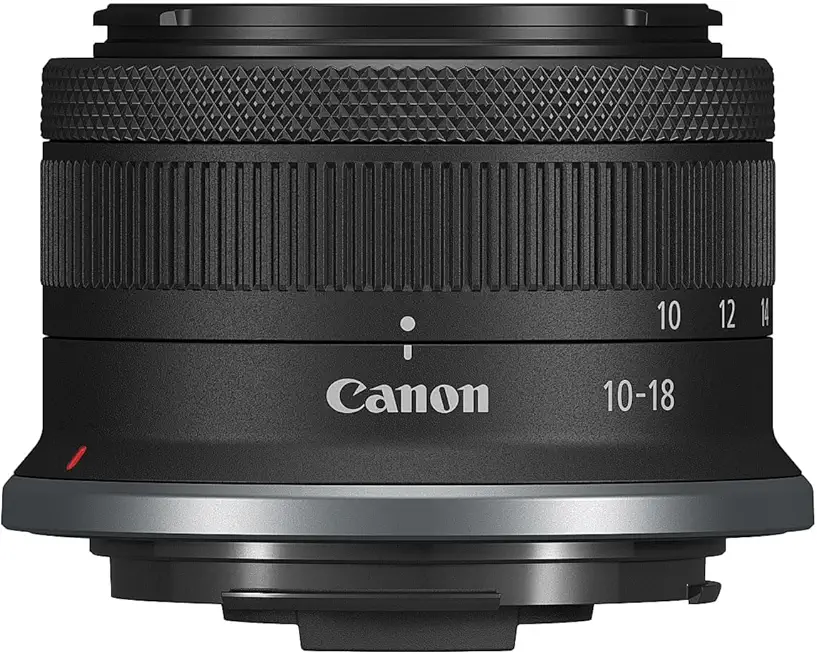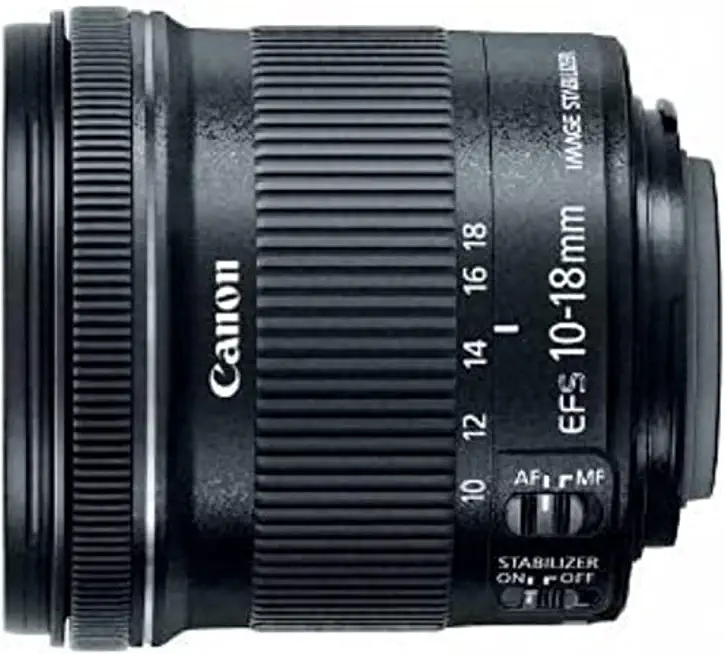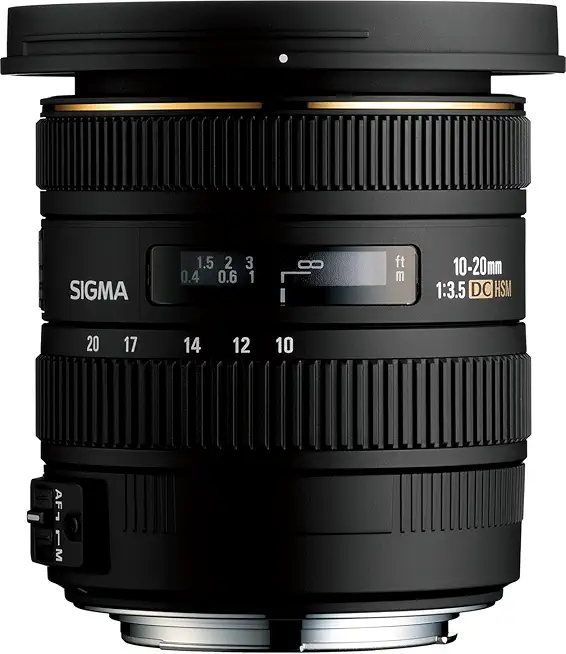
Want ultra-wide shots without a heavy bag or awkward framing? The Canon RF-S 10-18mm f/4.5-6.3 can change that, and it’s small enough for any travel kit.
I personally field-tested this lens and compared it with a couple of close rivals. I shot vlogs, interiors, and landscapes to see real differences.
If you’re a traveler, vlogger, or interior shooter on an APS-C EOS R body, this lens’s meant for you. It’s tiny, practical, and fast to grab.
Its best bits are real-world. It’s got steady optical stabilization, whisper-quiet STM autofocus, and featherweight portability that makes handheld interiors and travel video more reliable.
There’s a headline compromise to know. The aperture changes as you zoom, so low-light performance and creamy background blur are limited.
Yet the payoff is fewer missed shots, a lighter bag, and easier travel. I’ll reveal something shocking about this lens that might change your photo quality drastically — keep reading.

Canon RF-S 10-18mm f/4.5-6.3
Ultra-wide zoom for crop-sensor mirrorless cameras, lightweight and portable, delivers sweeping landscapes, dramatic perspectives, and reliable autofocus—perfect for travel, architecture, vlogging, and creative environmental portraits.
Check PriceThe Numbers You Need
| Spec | Value |
|---|---|
| Name | Canon RF-S 10-18mm F4.5-6.3 IS STM |
| Mount | Canon RF mount (APS-C) |
| Format | Designed for APS-C sensors |
| Year announced | November 2023 |
| Focal length | 10–18mm |
| Full-frame equivalent focal length | ≈16–29mm (full-frame equivalent) |
| Maximum aperture range | f/4.5–6.3 |
| Weather sealing | Not weather-sealed |
| Optical special elements | Includes 2 UD elements and 1 aspherical element |
| Minimum focus distance (AF) | 0.14 m / 5.5 in (AF) |
| Maximum magnification (AF) | 0.23× (AF at 18mm) |
| Image stabilization | Optical IS ≈4 stops; up to ≈6 stops with compatible IBIS |
| Filter thread | 49 mm |
| Dimensions | ~44.9 mm length (retracted) × 69 mm diameter |
| Weight | ~150 g |
How It’s Built
The Canon RF-S 10-18mm f/4.5-6.3 is built around a very lightweight plastic shell and an RF-S mount designed for APS-C bodies. In my testing this lens stayed tiny and pocketable thanks to its retractable design. There’s no weather-sealing gasket at the mount.
Internals use a mix of plastic and glass elements with a smooth, compact mechanism that barely extends when zooming. I found the build feels precise for the price and the moving parts don’t wobble. The focus and zoom rings are small but give predictable control.
This lens lacks official weather sealing so it’s not a go-to in heavy rain or dusty shoots. After using this lens I treated it like delicate gear around sand and drizzle and carried a rain cover for safety. For many casual shooters that extra caution is worth the trade for lightness.
Optical design includes UD and an aspherical element and I could see the benefit in cleaner edges and reduced color fringing. What I liked was how light and balanced it feels on small bodies; what could be better is a tougher, more weather-resistant mount.
For beginners this means easy day-long carrying and steady handholding without getting worn out. But be mindful: treat it gently and keep a cover handy if you’re shooting outside.
In Your Hands
The Canon RF-S 10-18mm f/4.5-6.3 greets your hand with an unmistakably compact, lightweight build that feels more travel‑ready than toyish; the plastic exterior is smooth and neatly finished, offering enough grip to feel secure. This lens sits wonderfully balanced on a mid-sized mirrorless body, remaining comfortable for long handheld runs, and it still feels surprisingly manageable on larger bodies thanks to its low mass. The overall tactile impression is of a tool designed for run‑and‑gun shooting rather than heavy tripod work.
Zoom and focus rings are small but well judged, with the zoom moving smoothly and without slack and the focus ring delivering a linear, predictable focus‑by‑wire response ideal for video racking. Autofocus via the quiet STM feels cooperative rather than intrusive, so manual adjustments and AF transitions play nicely together. External controls are deliberately minimal — there’s no dedicated focus‑lock or DOF scale — which keeps the barrel clean but pushes some routine adjustments to the camera body or menus.
There isn’t a separate zoom lock, but the retractable design and restrained extension mean zoom creep is effectively negligible in everyday use. Slight focus breathing is tamed by on‑lens corrections and rarely interferes with framing in vlogging or interiors work. In practice, handling favors simplicity and portability, making this lens an easy companion for travel and run‑and‑gun shooting.
Autofocus & Image Stabilization
The Canon RF-S 10-18mm f/4.5-6.3 brings a video-oriented STM drive that’s been tuned for mirrorless APS-C bodies. In everyday shooting this lens delivers quiet, smooth locking and generally reliable tracking. Its standout strength is that hushed, confident autofocus behavior that makes run-and-gun video painless.
On my test bodies AF felt snappy and accurate on stills and video, with only occasional hesitation in very low-contrast or dim scenes. The motor remains whisper-quiet under normal use, so you won’t pick up hunting noise on camera. A notable limitation is the absence of a mechanical focus clutch, so manual transitions are electronic rather than tactile.
Stabilization is one of this lens’s best real-world traits, producing steady handheld footage and a reassuring in-view feel. When paired with a body that has in-body stabilization the combined system becomes markedly smoother and more usable for longer takes. I noticed no intrusive stabilization chatter or distracting actuator noise during pans.
Focus breathing correction helps keep framing shifts to a minimum during racking, which is a boon for vloggers and short-form creators. Manual focus-by-wire is linear and predictable for smooth pulls, making this lens very video-friendly overall despite the few limitations for more demanding manual shooters.
Picture Quality Performance
The Canon RF-S 10-18mm f/4.5-6.3 shows the kind of real-world sharpness that makes it punch above its size; centers are pleasingly crisp straight away and detail improves noticeably when you stop down. Edge and corner performance is a bit more dependent on focal length, with the wide end showing the biggest gains as you tighten the aperture. Overall resolution is very usable for landscapes, interiors and video applications on APS-C bodies.
Barrel distortion at the widest settings is visible in straight-line subjects but is easily tamed in processing or by careful composition. Vignetting is most apparent at the wide end when used wide open, and it softens when stopped down or corrected in software. Chromatic aberration is surprisingly well controlled thanks to the optical design, with only occasional fringing in high-contrast transitions.
Bokeh is never the selling point here, since subject isolation is limited by the modest aperture, but out-of-focus areas render smoothly for backgrounds that are not too busy. Coma is modest and rarely a problem for night-sky shots, while sunstars are restrained rather than aggressive given the aperture character. Edge cat’s-eye can appear in close wide-angle shots but is typical for this class.
Flare and ghosting resistance are good for an ultra-wide, keeping contrast solid even with bright sources just outside the frame. In short, this lens delivers practical, well-rounded image quality with clear strengths in center sharpness and control of aberrations, balanced by the usual compromises of an ultra-wide, compact design.
How It Performs in Practice
I grab this lens when I want something tiny that doesn’t weigh me down. It feels almost toy-like in the hand but balances nicely on small EOS R bodies. The retractable barrel and light weight make all-day carry easy.
The max aperture is slow so low-light shots need higher ISOs more than I’d like. Still, the optical IS and combined IBIS on compatible bodies let me hold the camera steady for shots and smooth handheld video. That stabilization really saves images when I can’t use a tripod.
Autofocus is quiet and smooth for run-and-gun shooting and video racking is predictable. Manual focus is by-wire but feels linear enough for small tweaks. It rarely hunts and stays locked on most scenes.
One night in a tiny chapel I had to shoot a ceremony from the back row. I stopped down to control distortion, leaned on IS and got usable frames at slow shutter speeds, but the high ISO showed up as noise. The wide close-focus let me grab a candle detail that became one of my favorites.
This lens shines on interiors, architecture, landscapes and vlogging where ultra-wide reach and portability matter. The annoying bits are the slow aperture, lack of weather sealing, and no hood in the box. Still, for travel and run-and-gun work it often feels like the right compromise.
The Good and Bad
- Sharp and consistent image quality across the zoom range, especially when stopped down
- Very lightweight and compact, excellent for travel and handheld shooting
- Effective optical Image Stabilizer providing ~4 stops, up to ~6 stops with compatible IBIS bodies
- Quiet, smooth STM autofocus optimized for video and vlogging
- Maximum aperture is relatively slow (f/4.5–6.3), limiting low-light and bokeh performance
- No weather sealing, reducing durability in adverse conditions
- No hood included in the box; hood must be purchased separately
- Designed for APS-C sensors only; full-frame EOS R bodies must use crop mode
Better Alternatives?
We’ve covered the Canon RF-S 10-18mm and what it does well: tiny size, good stabilization, quiet AF, and great for travel, vlogging, and interiors on APS-C EOS R bodies. But that modest f/4.5–6.3 aperture and the small size mean there are trade-offs — especially in low light, reach, and build feel.
If you want something different — cheaper, wider-ranging, or faster — there are a few lenses I’ve used that I’d reach for instead in specific situations. Below are three real-world alternatives, what they do better and worse than the RF-S, and the kinds of shooters who will like each one.
Alternative 1:


Canon EF-S 10-18mm f/4.5-5.6
Budget-friendly ultra-wide zoom designed for crop-sensor DSLRs, exceptionally lightweight and easy to use, produces expansive landscapes and interiors with sharp autofocus and pleasing optical performance for everyday shooting.
Check PriceI’ve used the EF-S 10-18mm a lot as a cheap, lightweight ultra-wide. What it does better than the RF-S is price and availability — you can find it new or used for very little money — and it still gives that classic ultra-wide look that’s great for landscapes and small rooms. It’s really light and easy to carry all day.
What it does worse than the RF-S is modern mirrorless friendliness. The EF-S is made for older Canon DSLRs, so on an EOS R body you’ll need an adapter. That adds bulk and you lose the RF-S’s newer stabilization/tuning that works nicely with in-body IS and mirrorless AF profiles. In practice the EF-S can still focus well and make fine images, but the handling and stabilization feel different on newer bodies.
If you’re on a tight budget, shooting with an older Canon DSLR, or you want a cheap backup lens for travel, this is a solid pick. I’d recommend it to beginners, hobbyists, or anyone who wants the widest view for the least money and doesn’t mind using an adapter on a mirrorless camera.
Alternative 2:


Tamron 10-24mm f/3.5-4.5
Versatile wide-to-ultrawide zoom offering flexible framing, sharp optics, and close-focusing capability; built for landscapes, architecture, and street photography with smooth zoom action and dependable all-day performance.
Check PriceThe Tamron 10-24mm gives you more framing options than the RF-S because it reaches out to 24mm — that extra reach matters when you want a little tighter composition without switching lenses. In my shooting the Tamron also feels more solid in the hand and can be a touch faster in low light thanks to the wider aperture range at some focal lengths. That makes it a nice all-day lens for landscapes and streets where you want flexibility.
Where it falls short compared to the RF-S is size and weight. The Tamron is noticeably bigger and heavier, so it’s not as friendly for vloggers or pack-light travel. It’s also an older DSLR-era design for many mounts, so on an EOS R body you’ll again likely use an adapter and won’t get the same native mirrorless stabilization behavior. Autofocus is dependable, but the RF-S feels a bit snappier and quieter for video work.
Pick the Tamron if you want a single wide-range lens that covers more ground — landscapes, architecture, and street shooters who don’t mind a bit more weight will love it. It’s for photographers who want flexibility in framing and better low-light performance than the tiny RF-S, and who prioritize image options over pocketability.
Alternative 3:


Sigma 10-20mm f/3.5 EX
Fast constant-aperture wide-angle ideal for low-light scenes and dramatic perspectives; ruggedly constructed with excellent corner-to-corner sharpness, rendering starry skies, interiors, and dynamic compositions with confidence.
Check PriceThe Sigma 10-20mm f/3.5 stands out for one simple reason: that constant f/3.5 aperture. I’ve used it for night skies and dim interiors where the RF-S just can’t keep up. The extra stop or more of light makes a real difference — you can shoot slower ISOs and get sharper stars or cleaner indoor shots without a flash. The Sigma also feels well built and gives very nice corner-to-corner sharpness.
The trade-offs are practical. The Sigma is larger and heavier than the RF-S, has older autofocus that can be louder or slower on some bodies, and typically doesn’t have the same kind of modern stabilization the RF-S offers. On mirrorless you’ll need an adapter, and handheld video work is tougher because the RF-S’s tiny size and coordinated IS are hard to beat for smooth footage.
Choose the Sigma if you shoot a lot of night sky, indoor available-light work, or want the fastest ultra-wide on a budget. I’d hand this to landscape photographers who do star fields, event shooters in dim venues, or anyone who needs more light-gathering than the RF-S can provide and can live with the extra size and older AF characteristics.
What People Ask Most
Is the Canon RF-S 10-18mm F4.5-6.3 IS STM compatible with full-frame EOS R cameras?
It’s designed for APS-C RF-S mount bodies; you can mount it on a full-frame EOS R but the camera will use crop mode (1.6x), reducing resolution and field of view.
What is the difference between the RF-S 10-18mm and EF-S 10-18mm lenses?
The RF-S is a newer mirrorless design with improved optical IS and a video-optimized STM focus motor, while the EF-S is the older DSLR-era design for EF-S mounts.
Does the lens have image stabilization?
Yes — it has optical IS rated around 4 stops and can reach about 6 stops when combined with compatible in-body IBIS.
Does it come with a lens hood?
No, a hood is not included; the compatible hood (Canon EW-53B) is sold separately.
What autofocus motor does this lens use?
It uses a lead screw-type STM motor, which is quiet, smooth, and optimized for video autofocus.
What is the minimum focusing distance?
Autofocus minimum distance is 0.14 m (5.5 in); in manual focus at 10mm it can focus as close as 0.086 m (3.4 in).
Can I use this lens for vlogging?
Yes — it’s excellent for vlogging on APS-C EOS R bodies thanks to its ultra-wide view, light weight, quiet AF, and strong stabilization, though the slow aperture limits low-light and background separation.
Who This Lens Is / Isn’t For
If you use an APS-C EOS R camera and want something tiny and light, this lens is a great match. Photographers who travel, vlog, or shoot interiors will love it because it’s easy to carry and steady for handheld work. Beginners and hobbyists on a budget who want dramatic wide views without hauling heavy gear will appreciate this lens.
This lens really shines on tight interiors, architecture, landscapes, and run-and-gun video where wide coverage and stabilization matter more than shallow depth of field. Its close-focusing and compact size let you get creative wide-angle shots and keep moving easily between locations. On a stabilized body you can get usable low-light handheld photos and smooth video that looks pro without extra rigs.
Skip this lens if you need fast apertures for low light, subject isolation, or creamy bokeh in portraits. Also avoid it if you work in bad weather and need weather-sealed pro glass, or if you shoot sports and need long reach or very fast focus tracking. Full-frame shooters wanting full-frame coverage should look elsewhere unless they plan to accept crop mode.
Should You Buy It?
The Canon RF-S 10-18mm f/4.5-6.3 is a compact, purpose-built ultra-wide for APS-C shooters who prioritize portability and stabilized video performance. This lens nails what it sets out to do: ultra-wide coverage paired with impressively quiet autofocus and steady in-lens stabilization optimized for handheld video. Its small size and light weight make it an effortless everyday carry.
Its modest maximum aperture limits low-light performance and shallow depth-of-field control, so subject separation is not its strong suit. This lens also lacks weather sealing and omits an included hood, which undercuts durability and value for outdoor or professional use. Those are real compromises you accept for the compact design.
Sharpness and stabilization punch above what you might expect from such a tiny zoom, delivering usable detail and steady footage across common shooting scenarios. This lens rewards photographers and vloggers who value portability, close-focusing creativity, and unobtrusive operation over maximum speed or dramatic background blur. Compared with older alternatives, it feels modern and purpose-built.
Ultimately, buy this lens if you are an APS-C EOS R user seeking an ultra-wide that travels light and shoots steady, particularly for interiors, architecture, landscapes and vlogging. Skip it if you need fast apertures, robust weatherproofing, or maximum subject isolation for professional work. For most run-and-gun shooters, this lens is an excellent, practical choice.



Canon RF-S 10-18mm f/4.5-6.3
Ultra-wide zoom for crop-sensor mirrorless cameras, lightweight and portable, delivers sweeping landscapes, dramatic perspectives, and reliable autofocus—perfect for travel, architecture, vlogging, and creative environmental portraits.
Check Price

0 Comments